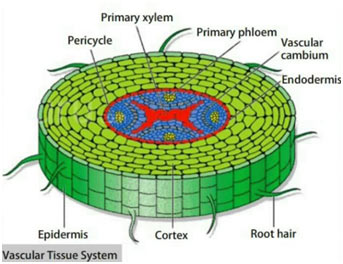Introduction
Roots are important to the plant in a variety of means: they provide stability, nutrients, as well as function as the key resource of water and nutrient absorption. In general, the root consists of all parts of the plant that lie under the soil, despite the fact that a lot of the tissues of the plant, including the vascular tissues, are continual throughout the root and shoot.
Roots might be primary or tap and adventitious roots. Taproots arise from the embryo whereas adventitious root develops from other mature cells of plant-like stem etc. The root contains three unique sorts of tissue systems i.e., epidermis, cortex as well as vascular tissues system. There is a root cap on taproots.
Epidermis
The epidermis of the root is used for the absorption of water and minerals. It births root hairs. Root hairs are tubular extensions of the external walls of the epidermis cells. The root hairs bearing cells are smaller sized than other cells. Some epidermis cells possess a slim layer of cuticle. The absorptive surface area of epidermis cells is increased by root hairs.
Root hair
An expansion of specialized root epidermis cells raising area for absorption of water and minerals. A root hair begins its development as a small papilla on the outer wall. The nucleus and cytoplasm migrate right into the papilla. The papilla expands and achieves maximum dimension. Its wall surface ends up being rigid due to the deposition of pectic compounds.

Cortex
The root cortex is composed of parenchyma cells. The innermost layer is the endodermis. Endodermis surrounds the stele. Older roots likewise have collenchymatous or sclerenchymatous cells. Intracellular cell spaces are frequently found in cortical cells of some roots.
Cortical cells have starch grain yet they lack chloroplasts. One or more layers of cortex below the epidermis ended up being a thick wall surface to create exodermis. The exodermis function as a protective layer. Its wall surface develops suberin lamella of variable density.

Endodermis
In primary roots, the internal most layer of the cortex stands out and is well developed. It is called endodermis. The cells of this layer are rectangle-shaped in outline. A band of suberin establishes around the cell in the middle of the transverse and also radial walls. This suberin band is called Casparian strip.
The Casparian band checks the outward flow of the absorbing materials. As a result, these materials need to pass through the cytoplasm of the endodermis cell as well as enter into the xylem. Hence, endodermis regulates the motion of soaked up materials. The endodermis and cortex are burst throughout the secondary growth of the root.
Vascular tissues
The whole area internal to the endodermis forms the stele. The stele is composed of complying with cells:

-
Parenchyma:
The external most part of the stele consists of several layers of parenchymatous cells. The external layer of this parenchyma is called the pericycle.
-
Xylem:
The xylem develops a solid central core in the gymnosperms as well as the dicotyledonous root. The outer margin of this central core has ridges. These ridges expand in the direction of the pericycle. The variety of xylem ridges varies in different plants. The protoxylem elements at the tips of the ridges are narrow. They have reticulated, annular, or spiral coagulations on their wall surfaces.
The xylem elements are wider in the central region. It consists of a metaxylem. This type of plan in which the protoxylem exists towards the outside and also the metaxylem lies towards the inside is called an exarch.
-
Phloem:
The phloem hairs are alternative with their ridge of the xylem as well as have the very same number. In each phloem, the protophloem elements exist in the direction of the outside, and also metaphloem is present towards the inner side. Phloem includes sieve tube elements, parenchyma, and a couple of fibers.
-
Cambium:
A parenchymatous sheet of cells separates the phloem hairs from xylem. It comes to be meristematic cambium at the start of secondary development.
-
Pith:
In some plants, few parenchyma cells are present in the center of the xylem core to develop pith.
Root cap:
Root cap is present at the tip of the root. It safeguards the underlying apical meristem. Root caps additionally help in the penetration of roots in the soil. Root cap likewise manages the geotropic action of origin. The cells of the root cap are living and consist of bountiful starch grain.
The wall surfaces of the cell are mucilaginous which help in the progressive sloughing of cells from the external layer. Apical meristems add new cells and also boost the thickness of the root cap. Primary cells of root caps in several parts develop a constant structure called the columella. Root caps are not established when plants are grown in solutions.


